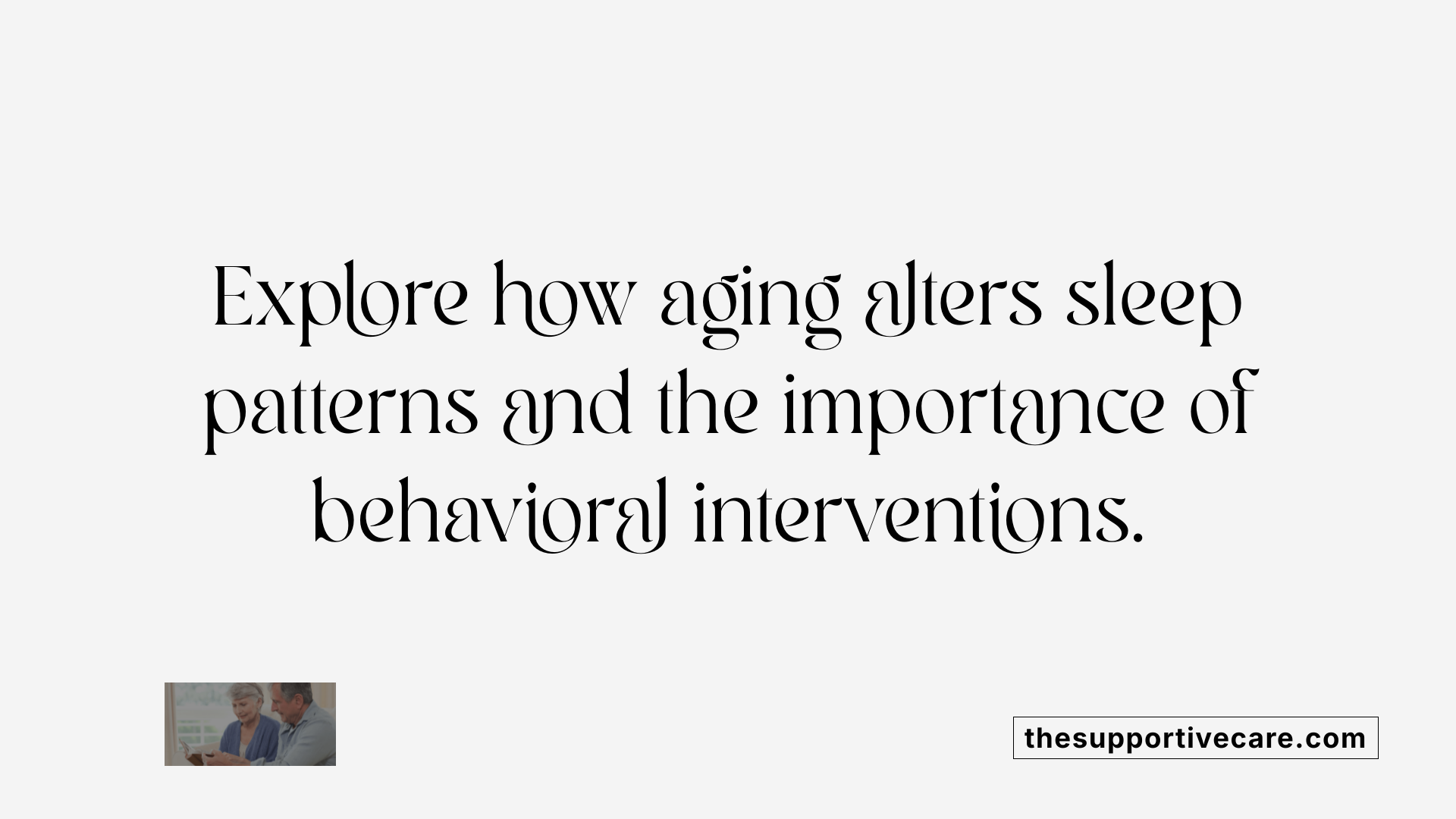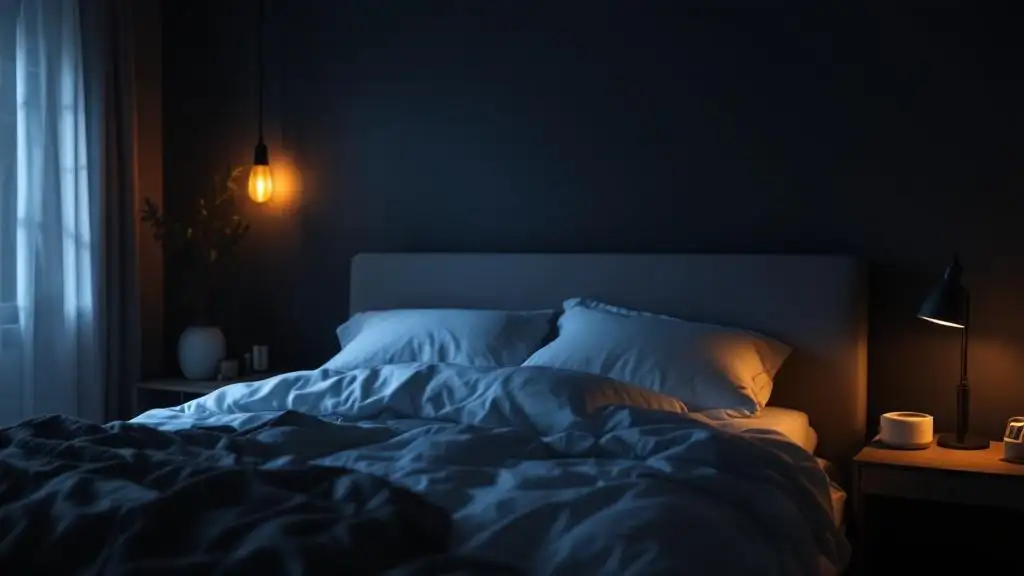Understanding Sleep Changes and Interventions in the Elderly
Sleep disturbances are highly prevalent among older adults, affecting their health, safety, and quality of life. As biological and environmental factors evolve with age, so do the challenges in achieving restful sleep. This article explores evidence-based behavioral interventions designed to address these sleep issues, emphasizing their safety, efficacy, and practical implementation tailored for the elderly population.
Biological Changes in Sleep with Aging

What are the main behavioral interventions for improving sleep in the elderly?
Behavioral strategies are central to managing sleep issues in older adults and serve as first-line treatments. The most prominent is cognitive-behavioral therapy for insomnia (CBT-I). This approach focuses on altering negative thoughts and behaviors that contribute to persistent sleep problems.
Key components of CBT-I include sleep hygiene education, which involves maintaining a comfortable and dark sleep environment, sticking to a consistent sleep schedule, and avoiding stimulants like caffeine close to bedtime. Stimulus control therapy encourages using the bed solely for sleep and sex, and getting out of bed if unable to fall asleep within a set time to break the association with wakefulness.
Sleep restriction therapy consolidates sleep by limiting time in bed to match actual sleep duration, which improves sleep efficiency over time. Relaxation techniques, such as progressive muscle relaxation or guided imagery, help reduce tension and racing thoughts that hinder sleep. Cognitive restructuring addresses maladaptive beliefs about sleep, reducing anxiety and promoting a sense of control.
In addition to therapy, lifestyle modifications include regular physical activity, avoiding naps during the day, and creating an optimal sleep environment—cool, dark, and quiet. These behavioral techniques are favored due to their safety and long-lasting effects. Most studies show they can improve sleep maintenance, decrease night waking, and enhance overall sleep quality in the elderly.
Finally, integrating these behavioral strategies helps not only improve sleep but also reduces dependence on medications, minimizing potential side effects in this vulnerable population.
Prevalence and Impact of Sleep Disorders in Older Adults
What are the incidence rates of insomnia among older adults?
Sleep problems are highly prevalent in the elderly population, with estimates indicating that between 5% and 50% of healthy older individuals experience insomnia. Despite this high incidence, only a small fraction—about 19%—have their sleep issues documented by healthcare providers. Age-related changes such as earlier circadian rhythms, reduced time in deep and REM sleep, increased sleep latency, and frequent night awakenings contribute to the high prevalence of sleep disturbances.
How does sleep quality affect cognitive functioning in the elderly?
Deterioration in sleep quality is closely linked to cognitive decline in older adults. Fragmented sleep, decreased sleep efficiency, and reduced total sleep time are associated with poorer cognitive performance, increased risk of dementia, and difficulties with attention and memory. Objective sleep studies reveal declines in restorative sleep stages, exacerbating cognitive impairments. Addressing sleep issues can thus play a crucial role in maintaining cognitive health.
What are the effects of poor sleep on safety and mental health?
Poor sleep significantly impacts safety, increasing the risk of falls due to impaired balance and alertness. It also heightens the incidence of mood disorders such as depression and anxiety. Chronic insomnia and disturbed sleep patterns are associated with decreased quality of life, increased risk of cardiovascular problems, and other health complications. Effective management of sleep disturbances is essential to enhance overall safety and mental well-being in this vulnerable group.
| Aspect | Description | Additional Notes |
|---|---|---|
| Incidence of insomnia | 5% to 50% among healthy older adults | Wide variation due to methodological differences |
| Sleep quality and cognition | Sleep decline correlates with cognitive impairment | Reductions in REM and slow wave sleep are pivotal |
| Safety and mental health | Increased fall risk, depression, decreased QoL | Emphasizes the importance of sleep management |
Scientific evidence on behavioral strategies for sleep improvement
Research consistently supports behavioral interventions for improving sleep in older adults. Systematic reviews and clinical trials show that cognitive behavioral therapy for insomnia (CBT-I), sleep hygiene education, stimulus control, and sleep restriction are effective and safe. These interventions modulate age-related sleep architecture changes and circadian disruptions by promoting healthier sleep habits.
Neurophysiological studies highlight how behavioral strategies can counteract the decline in deep and REM sleep stages, thereby enhancing sleep quality. Combining behavioral techniques with exercise or mindfulness approaches further improves outcomes. Evidence from meta-analyses demonstrates that such interventions significantly reduce sleep latency, night waking, and improve overall sleep efficiency, making them preferable options over pharmacological treatments.
Overall, the robust scientific backing underscores that non-drug strategies are first-line, effective, and carry fewer risks for the elderly.
For further insights, researching 'sleep disorders in elderly research' can provide extensive, up-to-date information on ongoing studies and emerging therapies.
Mechanisms of Behavioral Interventions in Sleep Improvement

How effective are cognitive-behavioral therapy (CBT-I) and other non-pharmacological approaches for treating sleep disturbances in older adults?
Cognitive-behavioral therapy for insomnia (CBT-I) is considered the gold standard non-drug treatment for sleep problems in the elderly. Its effectiveness has been confirmed through numerous studies and meta-analyses involving older populations. These interventions target core issues related to poor sleep, such as negative thoughts about sleep, irregular sleep habits, and environmental factors.
Research shows that CBT-I significantly improves various sleep parameters. Patients typically experience increased sleep efficiency, which means they spend more time sleeping relative to time in bed. They also report reductions in sleep onset latency, meaning they fall asleep faster, and wake after sleep onset, leading to more consolidated sleep. Improvements in total sleep time are common, and many patients maintain these benefits long after completing therapy.
Meta-analyses involving dozens of randomized controlled trials reveal high response and remission rates, with the majority of patients experiencing meaningful relief from insomnia symptoms. Importantly, these improvements have been shown to persist over months or even years, making CBT-I a durable and sustainable treatment.
Compared to pharmacological approaches, CBT-I reduces or even eliminates the need for sleep medications. Patients often deprescribe sleep aids following successful therapy, decreasing their risk of medication-related side effects such as falls, confusion, or dependency.
In summary, non-pharmacological approaches like CBT-I are highly effective and are recommended as first-line treatments for sleep disturbances in older adults. They offer considerable benefits with a minimal risk profile, helping improve sleep quality and overall well-being in this vulnerable population.
Lifestyle Modifications for Better Sleep
How do lifestyle modifications like exercise contribute to better sleep in seniors?
Regular physical activity is a highly effective way to improve sleep quality in older adults. Both subjective reports and objective sleep measures show significant benefits from engaging in exercises such as aerobic workouts, strength training, yoga, Tai Chi, and other multicomponent routines.
Studies indicate that exercise interventions lasting from 8 weeks up to 6 months, performed at moderate intensity about three times weekly, yield the most notable improvements. These include reductions in sleep latency (time taken to fall asleep), decreased wakefulness after sleep onset, and increased overall sleep efficiency.
Exercise helps regulate the body's internal clock, or circadian rhythm, which tends to shift earlier with age. By encouraging a stronger synchronization with natural light-dark cycles, physical activity contributes to more consolidated and restful sleep.
Additionally, regular exercise may reduce symptoms of sleep disturbances by alleviating stress, improving mood, and promoting physical tiredness conducive to sleep. Importantly, adherence plays a crucial role; consistent participation at appropriate intensities maximizes benefits.
In summary, engaging in moderate, regular exercise tailored to individual capabilities is a cornerstone lifestyle change that can significantly enhance sleep health in elderly individuals, leading to better rest and improved overall well-being.
Scientific Evidence Supporting Behavioral Strategies
What scientific evidence supports behavioral strategies to improve sleep in older adults?
Extensive scientific research underpins the use of behavioral approaches for managing sleep problems in the elderly. Systematic reviews and meta-analyses of randomized controlled trials consistently demonstrate that interventions such as cognitive behavioral therapy for insomnia (CBT-I), sleep hygiene education, stimulus control therapy, and sleep restriction are effective in improving sleep quality.
Neurophysiological studies reveal age-related changes in sleep architecture, including reductions in deep sleep and REM duration, increased sleep fragmentation, and early awakenings. These alterations are linked to changes in brain regions like the suprachiasmatic nucleus (SCN) and shifts in circadian hormones such as melatonin. Behavioral strategies actively target these dysregulations by encouraging habits that reinforce healthy circadian rhythms and promote efficient sleep.
Research also highlights the positive impact of exercise, particularly moderate aerobic activity, along with mindfulness-based interventions like Mindfulness-Based Stress Reduction (MBSR). Such approaches have been shown to reduce anxiety, stress, and hyperarousal—common barriers to restful sleep. Combining physical activity with psychological techniques can produce synergistic effects, further enhancing sleep quality.
Studies on targeted behavioral treatments show durable improvements, with benefits observed immediately post-treatment and maintained over time in many cases. For instance, CBT-I results in significant reductions in sleep onset latency, wake after sleep onset, and improvements in sleep efficiency. These benefits result from cognitive restructuring and behavioral modifications that address maladaptive sleep habits and negative beliefs about sleep.
Overall, the convergence of neurophysiological evidence and clinical studies provides a strong scientific foundation supporting behavioral strategies as safe, effective, and first-line options for managing sleep difficulties in older adults.
Application of Behavioral Strategies—Sleep Hygiene and Surroundings
Principles of sleep hygiene
Implementing good sleep hygiene practices is fundamental for improving sleep quality among older adults. These principles include maintaining a consistent sleep schedule, going to bed and waking up at the same times every day, even on weekends. Creating a relaxing pre-sleep routine, avoiding stimulating activities before bed, and limiting screen exposure at least an hour before sleep are also recommended.
Avoiding caffeine, large meals, and alcohol close to bedtime helps prevent disruptions in sleep. It is important for seniors to use their bed only for sleep and sex, which reinforces the association between bed and sleep rather than wakefulness. These simple behavioral adjustments support the body's natural circadian rhythms and promote restful sleep.
Environmental modifications
Creating an optimal sleep environment is another critical aspect of sleep hygiene. The bedroom should be cool, dark, and quiet to facilitate sleep. Using blackout curtains or eye masks can block out light, while earplugs can reduce noise disturbances. Ensuring a comfortable mattress and pillows support good sleep posture.
Reducing clutter and electronic noise from devices like televisions or alarms can also improve sleep quality. For older adults, the environment can be further tailored by incorporating calming scents or using white noise machines, which can help mask background sounds that might disrupt sleep. These adjustments help minimize sleep fragmentation and early awakenings common in aging populations.
Education and patient engagement
Patient education about sleep hygiene principles and the importance of sleep health is vital for successful outcomes. Healthcare providers should communicate the benefits of behavioral changes clearly and empathetically, fostering active participation and understanding.
Engaging older adults in developing a personalized sleep plan increases adherence. Providing feedback through sleep logs or diaries helps reinforce positive behaviors and identify residual issues. Combined with behavioral therapy components like stimulus control and sleep restriction, education empowers seniors to take an active role in managing their sleep health.
These strategies, integrated within a broader cognitive-behavioral framework, serve as effective, low-risk approaches to address sleep disturbances. Their consistent application can significantly improve sleep maintenance, reduce night waking, and enhance overall well-being among elderly individuals.
Role of Exercise and Lifestyle Changes in Sleep Management

How do lifestyle modifications like exercise contribute to better sleep in seniors?
Lifestyle modifications, especially regular physical activity, play a crucial role in improving sleep among older adults. Research indicates that a consistent exercise routine can positively influence both how seniors perceive their sleep and what objective measurements reveal. Activities such as aerobic exercises, strength training, yoga, Tai Chi, and other multicomponent programs have demonstrated significant benefits.
Engaging in these exercises for periods ranging from 8 weeks to 6 months, typically at moderate intensity about three times weekly, has been associated with enhanced sleep quality and efficiency. For instance, many seniors experience reduced sleep latency, meaning they fall asleep faster, and decreased wakefulness during the night.
Exercise helps to regulate the body's internal clock, known as the circadian rhythm, which often shifts earlier with age. By reinforcing natural sleep-wake cycles, physical activity can promote more consistent and restorative sleep. Moreover, physical activity reduces symptoms of sleep disturbances by lowering anxiety and stress that often interfere with sleep.
Overall, maintaining a routine that incorporates moderate, enjoyable physical activities tailored to individual health and mobility levels is a highly effective lifestyle change. It not only boosts sleep but also supports overall well-being, physical health, and cognitive function, making it an essential component of sleep management in elderly populations.
Addressing Sleep Disturbances Associated with Chronic Conditions
Can behavioral interventions help manage sleep problems associated with chronic conditions such as depression or osteoarthritis?
Yes, behavioral interventions such as cognitive behavioral therapy for insomnia (CBT-I) are effective in managing sleep problems linked with chronic illnesses like depression and osteoarthritis.
CBT-I targets the core issues causing sleep disturbances. It helps modify unhelpful thoughts and behaviors related to sleep, leading to sustained improvements without the side effects often associated with medications.
The therapy typically includes components such as sleep restriction, stimulus control, relaxation training, and sleep hygiene education. These elements work together to restore normal sleep patterns and adapt healthier sleep habits.
Research shows that CBT-I can significantly improve sleep duration, reduce night awakenings, and boost sleep efficiency. Furthermore, meta-analyses indicate its benefits are durable, often lasting well beyond treatment completion.
Healthcare providers can deliver CBT-I in various settings, including primary care, and training for clinicians is increasing, making the therapy more accessible.
Ultimately, implementing behavioral strategies offers a safe, effective, and evidence-based approach to managing sleep issues intertwined with chronic health conditions.
Clinical Guidelines and Expert Recommendations
What do clinical guidelines and expert recommendations suggest regarding non-drug treatments for sleep problems in the elderly?
Evidence-based guidelines consistently advocate for the use of non-pharmacological methods as the first line of treatment for sleep issues among older adults. These therapies are supported by systematic reviews and high-quality research, highlighting their safety and long-term effectiveness.
Core approaches include cognitive-behavioral therapy for insomnia (CBT-I), which combines sleep hygiene education, stimulus control, sleep restriction, relaxation strategies, and cognitive restructuring. These components aim to modify behaviors and thoughts that interfere with sleep.
Other recommended interventions are environmental adjustments such as maintaining a dark, cool, and quiet bedroom, setting a consistent sleep schedule, and avoiding stimulants like caffeine before bedtime.
In addition to CBT-I, lifestyle modifications like moderate aerobic exercise, tai chi, and exposure to natural light are encouraged, as they have been shown to enhance sleep quality.
Careful management of underlying health conditions and medication reviews are also emphasized to optimize sleep.
Together, these strategies create a multifaceted, personalized plan that prioritizes safety, effectiveness, and durability, reducing reliance on medications that carry risks of adverse effects in the elderly.
Implementation challenges and solutions
Though evidence supports these non-drug approaches, implementing them in clinical practice can be challenging. Limited access to trained providers knowledgeable in behavioral sleep methods and patient adherence issues are common barriers.
To overcome these obstacles, expanding training programs for healthcare providers and integrating behavioral therapists into multidisciplinary teams are recommended. Telehealth delivery models can improve access, particularly in remote or underserved areas.
Educating patients about the benefits of non-pharmacological therapies and setting realistic expectations can also promote engagement. Combining behavioral interventions with physical activity, light therapy, or stress reduction techniques may be tailored to individual needs, enhancing durability and efficacy.
In summary, clinical guidelines promote a cautious, tailored, and comprehensive strategy for managing sleep problems in the elderly, emphasizing behavioral and environmental modifications as the foundation of care.
Safety and Methodological Considerations

What are the safety concerns and methodological considerations when applying behavioral approaches to sleep management in older populations?
Behavioral therapies for sleep issues in seniors are widely regarded as safe and effective first-line options. These interventions include sleep hygiene education, stimulus control therapy, sleep restriction, relaxation techniques, and cognitive-behavioral therapy for insomnia (CBT-I). They work by modifying behaviors, thoughts, and environmental factors that influence sleep patterns.
Since these strategies do not involve medications, they carry minimal risk of adverse effects, making them particularly suitable for elderly individuals who often face medication-related side effects or interactions. The safety profile of behavioral interventions underscores their value, especially given the vulnerabilities in older populations.
When applying these approaches, a thorough, individualized assessment is essential. Healthcare providers should take detailed sleep histories, including sleep patterns, medical conditions, medications, and lifestyle factors. Sleep diaries or logs serve as useful tools for monitoring progress and tailoring interventions effectively.
Methodologically, personalization of therapy is crucial. For example, sleep restriction should be carefully calibrated to avoid excessive daytime sleepiness, and relaxation techniques should consider the patient's physical limitations or cognitive impairments.
Monitoring adherence is another critical aspect; progress should be regularly reviewed to ensure compliance and effectiveness. Adjustments may be needed based on patient feedback and changing health status.
While behavioral therapies are associated with long-lasting improvements, clinicians must still consider comorbid conditions, such as depression or chronic pain, which can influence sleep and treatment outcomes.
Overall, these non-pharmacological strategies offer a safe, adaptable, and sustainable approach to managing sleep disturbances in older adults, provided they are implemented with careful assessment and ongoing support.
The Path Forward in Sleep Management for Older Adults
Behavioral interventions for sleep disturbances in the elderly are supported by robust scientific evidence and clinical guidelines, emphasizing safety, efficacy, and their role as the first-line treatment options. Combining strategies such as CBT-I, sleep hygiene, lifestyle modifications, and stress management can lead to meaningful and durable improvements in sleep quality, with added benefits like reduced medication dependence and enhanced overall well-being. Ongoing research aims to refine these approaches, improve adherence, and expand accessibility, including through digital and community-based programs. Tailoring interventions to individual needs and addressing comorbidities make behavioral strategies adaptable and sustainable. With continued emphasis on multidisciplinary and patient-centered care, addressing sleep disturbances in older adults can significantly improve their health and quality of life.
References
- Cognitive behavioural interventions for sleep problems in adults ...
- Behavioral and exercise interventions for sleep dysfunction in the ...
- Practical non-pharmacological intervention approaches for sleep ...
- Cognitive Behavioral Therapy for Insomnia Improves Sleep and ...
- Strategies for Managing Sleep Disorders in Older Adults
- Conquering Insomnia with Cognitive Behavioral Therapy (CBT)
- Behavioral and psychological treatments for chronic insomnia ...
- Cognitive Behavioral Therapy for Insomnia (CBT-I): An Overview




































































































